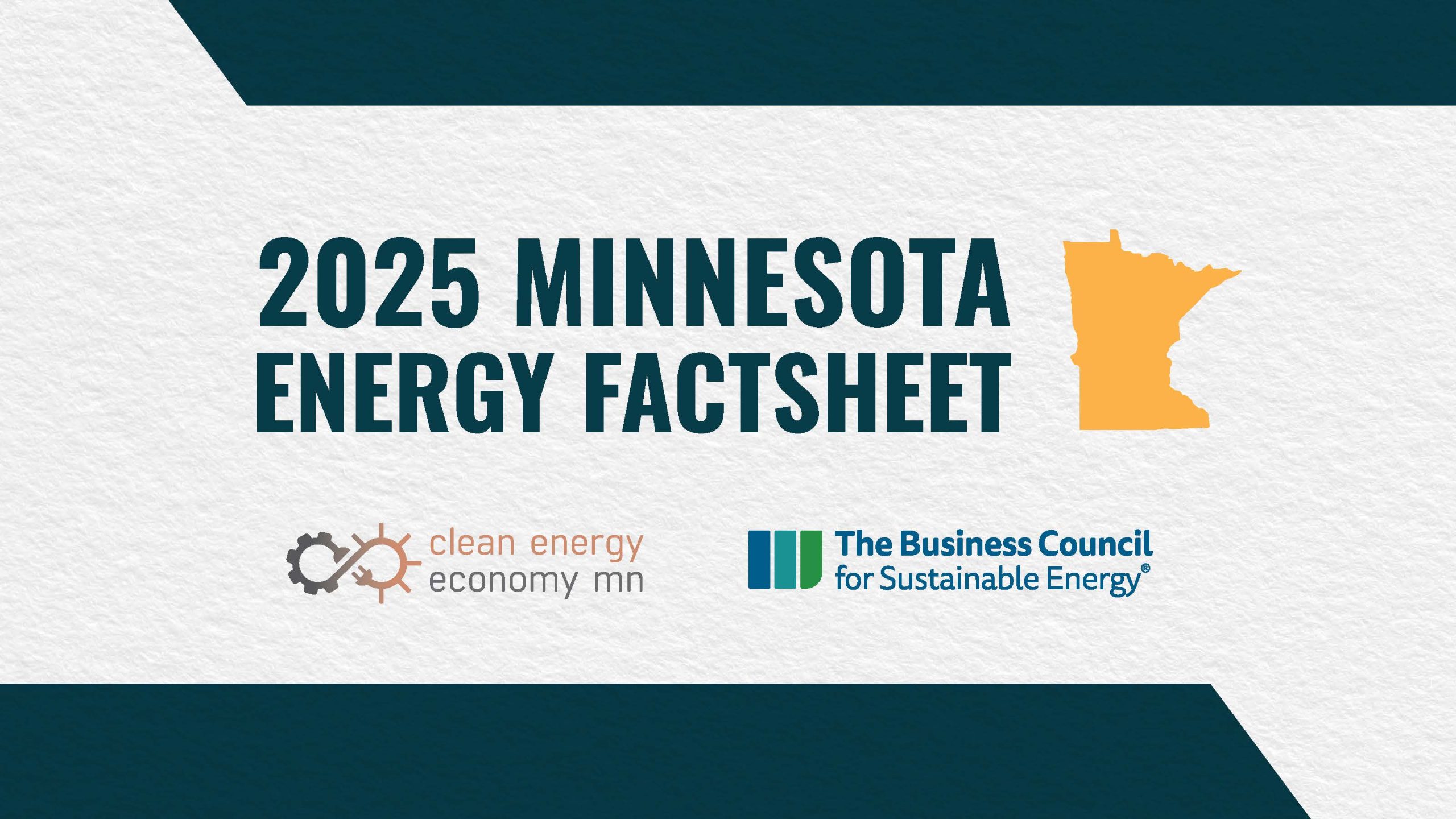MINNEAPOLIS — Minnesota has once again affirmed its leadership in the clean energy transition. The newly released 2025 Minnesota Energy Factsheet, developed by Clean Energy Economy Minnesota (CEEM) and the Business Council for Sustainable Energy (BCSE) with research by BloombergNEF and data from the Minnesota Department of Commerce, shows the state made significant strides in cutting emissions, maintaining a majority-zero-carbon power mix, and reducing reliance on imported electricity.
This is the fifth consecutive year that zero-carbon sources (renewables and nuclear) have provided the majority of Minnesota’s electricity, reaching 53% in 2024, well ahead of the national average of 42%.
Highlights from the 2025 Minnesota Energy Factsheet include:
- Record-low power sector emissions: Minnesota cut power sector carbon emissions by 4% from 2023 to 2024, reaching a level 52% below 2005, far ahead of the national average reduction of 38%.
- Reduced electricity imports: Imported electricity fell to just 11% of total use in 2024, down from 13% the previous year, demonstrating stronger in-state energy production and reliability.
- Consistent renewable generation: Renewable energy made up one-third of all electricity generated in 2024. In the past decade, coal’s share has dropped from 43% to 20%, while renewables and zero-carbon sources have steadily risen.
- Energy efficiency leadership: Minnesota was once again ranked No. 1 in the Midwest and No. 10 nationally by the American Council for an Energy-Efficient Economy (ACEEE) for overall energy efficiency.
- Rising productivity: Since 2001, Minnesota’s energy productivity has grown by 37%, including a 9% gain in the past five years — meaning the state is using energy more efficiently to generate economic value.
- Consumer savings: Businesses and households saved more than $307 million in energy costs from the Energy Conservation Optimization (ECO) Act during 2021 and 2022.
- EV growth and market shifts: Minnesota had 65,679 electric vehicles on the road as of November 2024. While total EV registrations grew, new registrations fell 44% from a record-high in 2023 amid a national slowdown in EV sales growth.
- Solar surges ahead: Preliminary data shows Minnesota added 388 megawatts of new solar capacity in 2024, a 35% increase over the prior year. Renewables made up 99% of new capacity added in the last five years.
- Innovation on the rise: Minnesota is positioning itself as a hub for next-generation energy technologies, including the production of clean hydrogen and sustainable aviation fuel (SAF).
“Minnesota’s commitment to clean energy is paying off, and we’re transitioning our power sector to reliable and efficient clean energy sources,” said Minnesota Governor Tim Walz. “These efforts are creating jobs, reducing emissions, and improving energy efficiency for consumers – all while cementing Minnesota as a national leader in sustainable energy.”
“This year’s factsheet underscores how Minnesota’s consistent, long-term commitment to clean energy is delivering real results,” said Gregg Mast, Executive Director of Clean Energy Economy MN. “From driving emissions to a new record low, to generating the majority of our power in-state and carbon-free, Minnesota continues to prove that smart policy and business innovation can go hand-in-hand to build an affordable, reliable, and resilient energy future.”
“Minnesota remains a national standout for its progress on energy efficiency and clean energy,” said Lisa Jacobson, President of BCSE. “The United States is on the cusp of an American energy expansion, and leadership from states like Minnesota is key to unlocking clean energy’s economic opportunity, driving down energy costs, and meeting demand growth.”
“The 2025 Factsheet is a clear picture of Minnesota’s clean energy economy on the rise,” said Minnesota Commerce Deputy Commissioner of Energy Resources Pete Wyckoff. “Minnesota is making the transition to more homegrown energy that is more affordable, cleaner, and reliable. We are saving energy and saving money for all Minnesotans. And we are creating jobs for a clean energy future.”
“What stood out to me was that 99% of new capacity added over the last five years came from renewables. That’s not just momentum—it’s market transformation,” said Corey Orehek, Ziegler Energy Solutions’ Sr. Business Developer. “For someone in the business of deploying energy solutions, it’s proof that Minnesota isn’t dabbling in clean energy anymore—it’s committing. That level of clarity helps us invest, hire, and build with confidence.”
The Factsheet is a companion to the 2025 Sustainable Energy in America Factbook, which provides valuable year-over-year data and insights on the American energy transformation. Both resources are commissioned by the Business Council for Sustainable Energy (BCSE) with research by BloombergNEF. The Minnesota Energy Factsheet is made possible with the support of the Full Stack Saint Paul, Marsh, and the McKnight Foundation.
Download the 2025 Minnesota Energy Factsheet today.
Media Contacts
| Lizzie Stricklin Business Council for Sustainable Energy 202.785.0507 x 1504 lstricklin@bcse.org |
Peter Ingraham Clean Energy Economy Minnesota 651.285.3917 pingraham@cleanenergyeconomymn.org |
About Clean Energy Economy Minnesota (CEEM): CEEM is an industry-led 501(c)(3) nonprofit representing the business voice for clean energy in Minnesota. CEEM provides a unified voice for clean energy business across the state. Our mission is to provide educational leadership, collaboration, and policy analysis that accelerates clean energy market growth and smart energy policies. Learn more at cleanenergyeconomymn.org.
About the Business Council for Sustainable Energy (BCSE): BCSE is a coalition of companies and trade associations that deploy clean energy and decarbonization solutions, with a sector focus on energy efficiency, natural gas, and renewable energy. Established in 1992, the coalition advocates at the federal level for policies that advance the deployment of a broad portfolio of clean energy technologies. Learn more at bcse.org.

